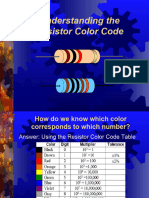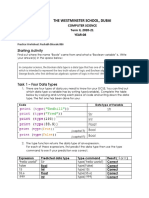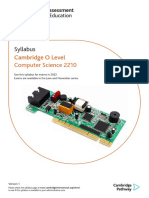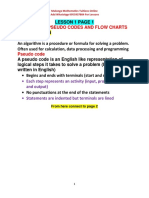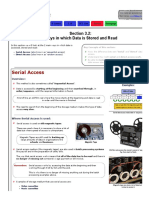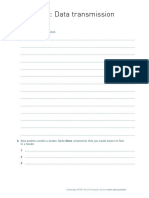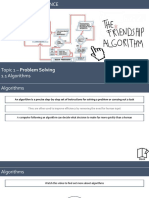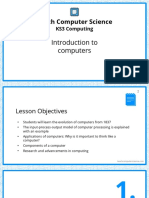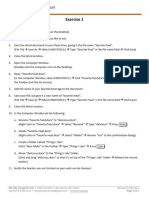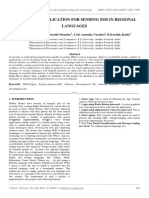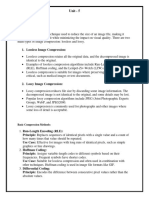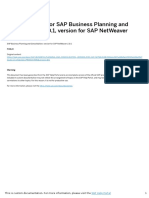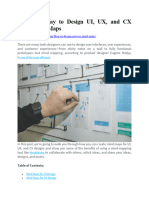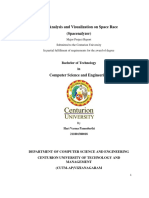P.E.S.
PU COLLEGE
Hanumanthanagar, Bangalore – 50
I PUC PREPARATORY EXAMINATION ( JAN – 2025)
COMPUTER SCIENCE (41)
Time: 3 hours. Max Marks: 70
PART - A
I. Answer ALL the questions. Each question carries ONE mark. 20 x 1 = 20
(only first written answers will be considered for evaluation)
1. __________ controls sequential instruction execution, interprets instructions and guides data flow
through the computer’s memory.
a) Control Unit b) Arithmetic-Logical Unit c) Memory Unit d) None of the above
2. Who invented the tabulating machine?
a) Charles Babbage b) Blaise Pascal c) Herman Hollerith d) William Oughtred
3. ASCII used __________ bits to represent characters.
a) 8 bits b) 7 bits c) 6 bits d) 9 bits
4. Spell checking features are examples of __________
a) Data Science b) Nero Science c) Natural Language Processing d) Machine Learning
5. Start / End also called __________ symbol, it indicates where the flow starts and ends.
a) Terminator b) Decision c) Input/output d) Action
6. A program written in a high-level language is called __________
a) Source code b) Object code c) Assembly code d) Machine code
7. __________ are reserved words in python?
a) Keyword b) Interpreter c) Program d) Object
8. __ is a sequence of items separated by commas and the items are enclosed in square brackets [ ]
a) List b) Tuple c) String d) Dictionary
9. What does continue statement do?
a) Print b) Stop c) Skip d) Repeat
10. In python, __________ statement returns the values from the function.
a) Reverse b) Return c) Back d) Continue
11. Each individual character in a string can be accessed using a technique called __________
a) Method b) Slicing c) Indexing d) Replication
12. __________ a single element passed as an argument at the end of the list.
a) append ( ) b) extend ( ) c) insert ( ) d) len ( )
13. Python allows us to join tuples using __________ operator.
a) Assignment b) Concatenation c) Repetition d) Slicing
14. In dictionaries key-value pair is called an __________
a) List b) Item c) Element d) Value
15. The actual implementation of the concept or invention will be protected by __________
a) Trademark b) Copyright c) Patent d) Plagiarism
�II. Fill in the blanks choosing the appropriate word from those given in brackets.
(selection, count( ), extend( ),modules, looping, debugging)
16. Identifying and removing bugs or errors from the program are also known as _______
17. The program is divided into different parts for complex problems called _______
18. The _______ function can append a list of elements to a list
19. _______ constructs provide the facility to execute a set of statements in a program repetitively,
based on a condition.
20. _______ returns the number of times the given element appears in the tuple.
PART - B
III. Answer any FOUR questions each carries TWO marks. 04 x 2 = 08
21. What is data? What are the types of data?
22. Briefly explain 2 types of execution modes.
23. Explain range ( ) function with syntax and example.
24. Explain string as a parameter with example.
25. Explain any 2 functions of tuple and 2 functions of dictionary.
26. Explain 2 types of digital footprints.
27. What are net etiquettes?
PART - C
IV. Answer any FOUR questions each carries THREE marks. 04 x 3 = 12
28. Explain the types of bus with its structure.
29. Write the steps to convert other number systems to decimal number system.
30. What are the characteristics of big data?
31. Write an algorithm and flowchart to calculate area and perimeter of a rectangle.
32. Explain the characteristics of algorithm.
33. Briefly explain types of errors with an example.
34. Explain any three operations on strings.
PART - D
V. Answer any FOUR questions each carries FIVE marks. 05 x 4 = 20
35. Explain in detail about the operating system interfaces.
36. Explain functional units of computer system with neat block diagram
37. Write a note on Block Chain.
38. What is problem solving? Explain the steps involved in problem solving.
39. Explain relational operators in python with an example.
40. Explain four possible ways of function with example.
41. Explain operations on list with examples.
VI. Answer any TWO questions each carries FIVE marks. 05 x 2 = 10
42. Convert: CAFÉ = (?)2 = (?)8 = (?)10
43. Write algorithm, pseudo code and draw flowchart to check whether the given number is positive or
negative or zero.
44. Explain in detail about selection statements.
*****





